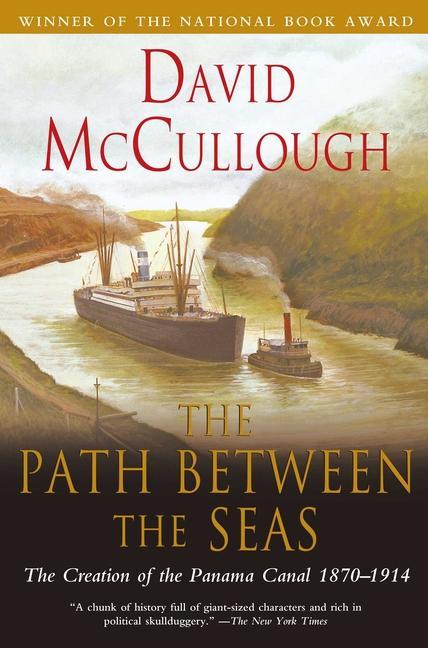Path Between The Seas : The Creation Of The Panama Canal, 1870- 1914 by David McCullough

View book: Path Between The Seas : The Creation Of The Panama Canal, 1870- 1914
The Path Between the Seas: A Captivating Tale of Overcoming Challenges to Connect Two Oceans
Discover the captivating story chronicled in The Path Between the Seas, a remarkable book that delves into the extraordinary efforts undertaken by a brave group of individuals to bring to life a centuries-old vision of connecting the Atlantic and Pacific oceans. In this fascinating account, author David McCullough unveils not only the astonishing engineering achievements but also the monumental medical breakthroughs, political maneuvering, heroic triumphs, and heartbreaking misfortunes that comprised this historical feat.
Achieving the Impossible
Against all odds, the men and women whose stories are depicted in this book persevered, determined to overcome every obstacle hindering the construction of an aquatic passageway between two vast oceans. Their relentless pursuit of this 400-year-old dream is a testament to the indomitable human spirit.
Awe-Inspiring Engineering Marvels
The book delves deeply into the extraordinary engineering accomplishments that propelled this ambitious project forward. From designing intricate locks and canals to harnessing the mighty force of water, these individuals pushed the boundaries of scientific knowledge and expertise.
Revolutionizing Medicine
The narrative also highlights the tremendous medical advancements that were made during the course of this colossal endeavor. With tropical diseases, treacherous working conditions, and life-threatening challenges at every turn, brave medical pioneers pushed the boundaries of science to preserve and protect the lives of those involved.
The Struggles for Power
Integral to the story is the intricate web of political power plays that constantly threatened to derail the project. From international conflicts to relentless lobbying and negotiations, the battle for control and financial backing shaped the course of this ambitious undertaking.
A Journey of Triumphs and Tragedies
In recounting the countless moments of triumph and disaster, McCullough brings to life the individuals whose unwavering dedication resulted in historic successes and devastating failures. Their personal stories of sacrifice and bravery serve as a testament to the power of human resilience in the face of adversity.
A Captivating Tale Skillfully Told
Through his masterful storytelling, McCullough expertly weaves together the various strands of this monumental undertaking, providing readers with a comprehensive and engrossing account. His gift for lucid and lively exposition ensures that even the most complex details are accessible and engaging.
Final Thoughts
The pages of The Path Between the Seas echo with the triumphs of human ambition, the brilliance of scientific innovation, and the relentless pursuit of a seemingly impossible dream. McCullough’s unrivaled ability to tell a captivating tale leaves readers inspired, informed, and with a newfound appreciation for the extraordinary power of human resolve.
The Creation of the Panama Canal: Triumphs, Tragedies, and Global Impact
In the book “The Path Between Disease,” David McCullough recounts the remarkable story of the proposal, construction, and completion of the Panama Canal. Through his engaging storytelling style, McCullough brings the characters and their problems to life while providing historical context. This piece is accessible to the average citizen while also offering interesting insights for historians, students, and the general public alike.
McCullough organizes the book into three sections: the vision, stars-and-stripes, and the builders. Each section focuses on different aspects of the canal’s history, progressing chronologically and supporting the thesis that the success at Panama required new approaches and ideas. This organization allows McCullough to include specific details that establish his personal tone and create a collection of interconnected stories.
The book begins with a historical background of the canal, starting with its conceptualization by Alexander von Humboldt in the early 19th century. It then delves into the French chapter of the project, highlighting the accomplishments and failures of Ferdinand de Lesseps and his team. The story progresses into the American phase of the project, emphasizing the Panama Revolution backed by the United States and the achievements of American doctors and engineers.
The book explores the challenges faced during the construction of the canal, such as the difficult geography of Panama, the bankruptcy of the French effort, and the negotiations between the United States and Panama for control of the project. McCullough also highlights the high mortality rates among workers due to diseases such as yellow fever and malaria.
McCullough’s thorough research is evident in the extensive use of primary sources, including journals, diaries, scientific data, and letters, as well as secondary sources. These sources provide personal stories and lend credibility to McCullough’s thesis. His bias is minimal, and he presents a balanced portrayal of the main characters, particularly the Americans.
Overall, “The Path Between Disease” offers a diverse and reliable account of the history and construction of the Panama Canal. McCullough’s entertaining narrative style makes the book accessible and engaging for readers of all backgrounds. It has received positive reviews for its solid and fair-minded approach, and its ability to bring the intricate story of the canal to life.







Leave a Reply